An element’s CSS Height and Width can be set using CSS’s widhttps://codershot.com/?s=cssth and height attributes. An outline regarding how to apply these characteristics is provided here:
Table of Contents
ToggleHeight
In CSS, the height for an element can be specified using the height attribute. This property accepts many kinds of values, each of which has a unique function and offers layout design versatility. An extensive description and examples of using the height property are provided below.
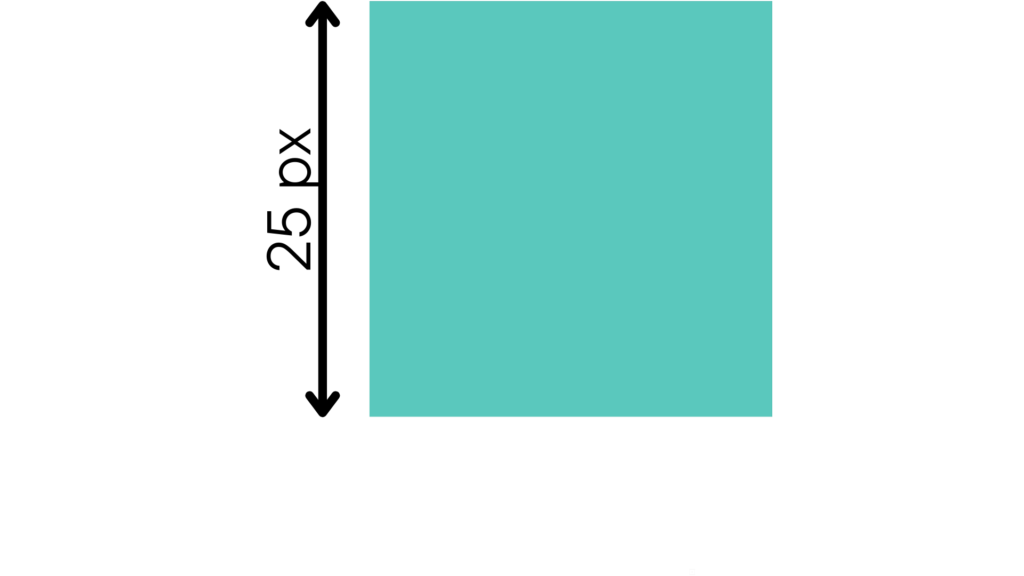
Syntax:
element {
height: value;
}
Possible Values:
- Fixed Values: Use measurements such as pixels (px), ems (em), rems (rem), and so forth to specify a fixed height.
.box {
height: 150 pixels; /* 150 pixel fixed height */
}
- Percentage Values: Values expressed as percentages: Indicate the height about the height of the parent element.
.box {
height: 50%; /* Height is 50% of the parent element's height */
}
- Auto Value: The element’s default value that modifies its height following its content.
.box {
height: auto; /* Height adjusts to fit the content */
}
- Viewport Units: 1vh is equivalent to 1% of the viewport height. Use viewport-relative units.
.box {
height: 50vh; /* Height is 50% of the viewport height */
}
- Min and Max Values: To impose height restrictions, use min- and max-height.
.box {
min-height: 100px; /* Minimum height of 100 pixels */
max-height: 300px; /* Maximum height of 300 pixels */
}
Special Considerations
- Content Overflow: Scrollbars or hidden content may appear if the content is larger than the allowed height. You can adjust this behavior with the overflow property.
.box {
height: 100px;
overflow: scroll; /* Adds scrollbars if content overflows */
}
- Box-Sizing: The content box is sized by default based on the height attribute. Padding and border are included in the height when using box-sizing: border-box;.
.box {
height: 150px;
padding: 10px;
border: 5px solid black;
box-sizing: border-box; /* Height includes padding and border */
}
Example
This is an extensive example that shows various approaches to setting the height property:
<!DOCTYPE html>
<html lang="en">
<head>
<meta charset="UTF-8">
<meta name="viewport" content="width=device-width, initial-scale=1.0">
<title>Height Property in CSS</title>
<style>
.fixed-height {
height: 150px;
background-color: lightblue;
}
.percentage-height {
height: 50%;
background-color: lightcoral;
}
.viewport-height {
height: 50vh;
background-color: lightgreen;
}
.auto-height {
height: auto;
background-color: lightgoldenrodyellow;
}
.min-max-height {
height: auto;
min-height: 100px;
max-height: 300px;
background-color: lightpink;
}
</style>
</head>
<body>
<div class="fixed-height">Fixed Height</div>
<div class="percentage-height">Percentage Height</div>
<div class="viewport-height">Viewport Height</div>
<div class="auto-height">Auto Height</div>
<div class="min-max-height">Min-Max Height</div>
</body>
</html>
Output :-
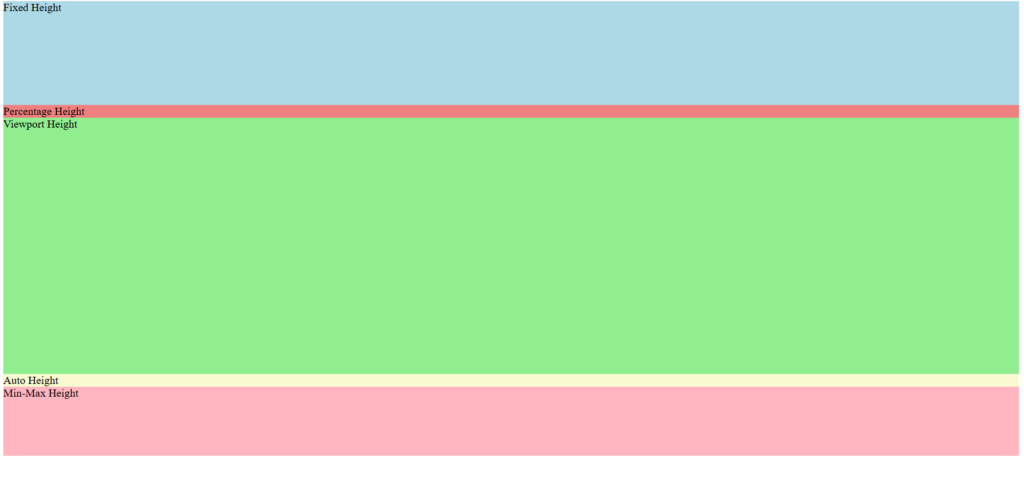
Explanation
- Fixed Height: 150 pixels is the fixed height of the—fixed-height element.
- Percentage Height: The height of the. percentage-height element is equal to 50% of the height of its parent element.
- Viewport Height: 50% of the viewport height is represented by the height of the—viewport-height element.
- Auto Height: Depending on its content, the. auto-height element modifies its height.
- Min-Max Height: When content falls into the designated range, the min-height and max-height restrictions of the. min-max-height element changes accordingly.
By correctly using the height property, you can make responsive and adaptable designs that guarantee elements function as intended across a range of screen sizes as well as content variations.
Width
The width property in CSS is used to specify the width of an element. Similar to the height property, it can take various values, providing flexibility for layout design. Here’s an in-depth description of the width property and how to use it:

Syntax
element {
width: value;
}
Possible Values
- Fixed Values: Use units such as pixels (px), ems (em), rems (rem), and so forth to specify a fixed width.
.box {
width: 300px; /* Fixed width of 300 pixels */
}
- Values expressed as percentages: Indicate the width in terms of the main element’s width.
.box {
width: 75%; /* Width is 75% of the parent element's width */
}
- Auto Value: The element’s default value that modifies its width by its content
.box {
width: auto; /* Width adjusts to fit the content */
}
- Units of Viewport: Put 1vw, or one-tenth of the viewport width, in viewport-relative units.
.box {
width: 50vw; /* Width is 50% of the viewport width */
}
- Min and Max Values: To impose width restrictions, use min- and max-width.
.box {
min-width: 200px; /* Minimum width of 200 pixels */
max-width: 500px; /* Maximum width of 500 pixels */
}
Special Considerations
- Content Overflow: Scrollbars or hidden content may appear if the content is wider than the allowed space. You can adjust this behavior with the overflow property.
.box {
width: 200px;
overflow: scroll; /* Adds scrollbars if content overflows */
}
- Box-Sizing: The content box is sized by default based on the width attribute. Padding and border are included in the width when box-sizing: border-box; is used.
.box {
width: 300px;
padding: 10px;
border: 5px solid black;
box-sizing: border-box; /* Width includes padding and border */
}
Example
This is a thorough example that shows various approaches to setting the width property:
<!DOCTYPE html>
<html lang="en">
<head>
<meta charset="UTF-8">
<meta name="viewport" content="width=device-width, initial-scale=1.0">
<title>Width Property in CSS</title>
<style>
.fixed-width {
width: 300px;
background-color: lightblue;
}
.percentage-width {
width: 50%;
background-color: lightcoral;
}
.viewport-width {
width: 50vw;
background-color: lightgreen;
}
.auto-width {
width: auto;
background-color: lightgoldenrodyellow;
}
.min-max-width {
width: auto;
min-width: 200px;
max-width: 500px;
background-color: lightpink;
}
</style>
</head>
<body>
<div class="fixed-width">Fixed Width</div>
<div class="percentage-width">Percentage Width</div>
<div class="viewport-width">Viewport Width</div>
<div class="auto-width">Auto Width</div>
<div class="min-max-width">Min-Max Width</div>
</body>
</html>
Width’s Output :-
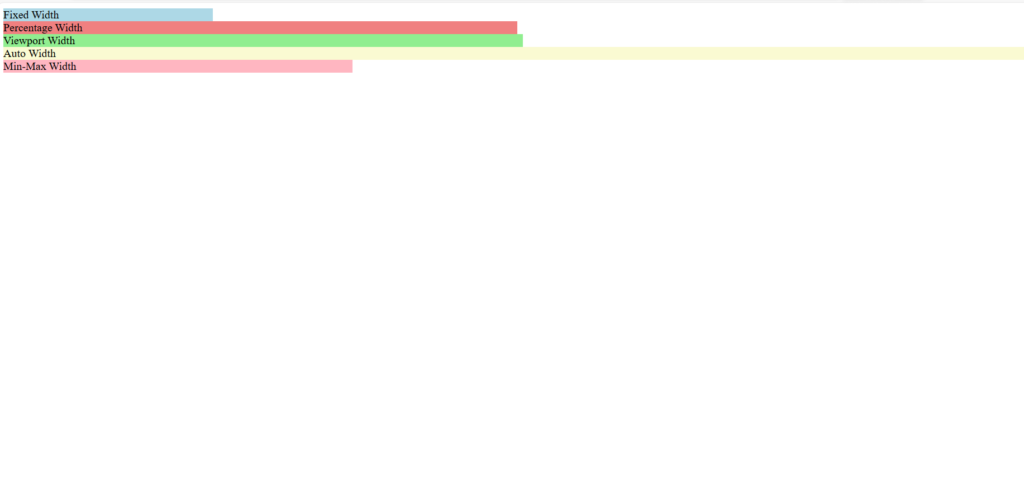
Explanation
- Fixed Width: The width of the. fixed-width element is set at 300 pixels. Percentage
- Width: The width of the. percentage-width element is equal to 50% of the width of its parent element.
- Viewport Width: 50% The total viewport width is represented by the width of the. viewport-width element.
- Auto Width: The width of the. auto-width element changes in response to its content.
- Min-Max Width: Based on content falling inside the designated range, the min-width and max-width constraints of the. min-max-width elements are adjusted.
Effective use of the width property enables you to produce responsive and adaptable designs, guaranteeing that elements function as intended across a range of sizes of screens and content modifications.
Height and Width
The height and width of an element can be set in CSS using its height and width attributes. Here’s a quick rundown of some applications for these properties:
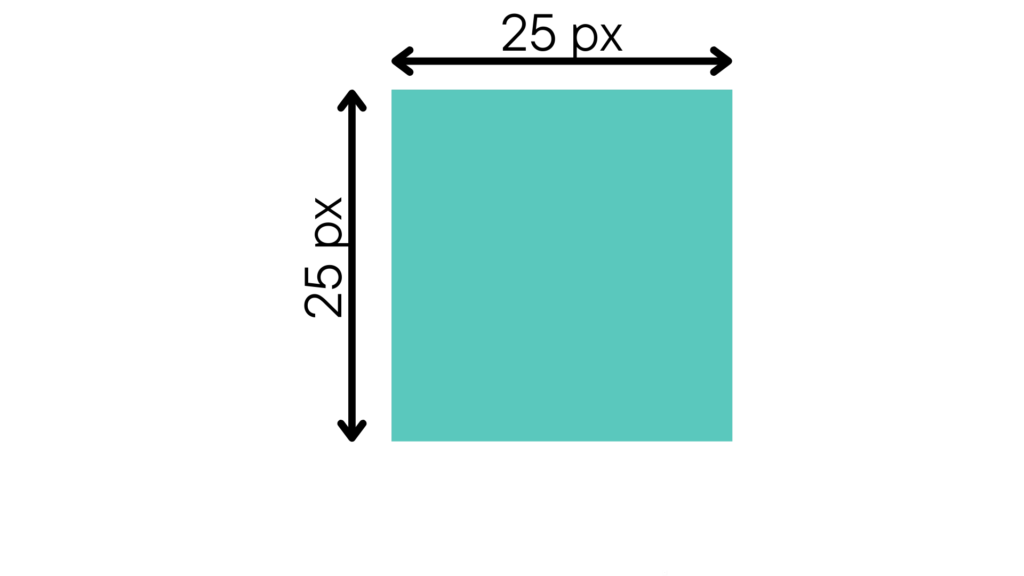
Setting Height and Width
- Fixed Values: Any CSS unit, including pixels (px) and points (pt), can be used to set fixed values.
.box {
height: 25px;
width: 25px;
}- Values in Percentage: Both height and width can be adjusted in percentage terms about the parental element.
.box {
height: 50%; /* 50% of the parent element's height */
width: 75%; /* 75% of the parent element's width */
}
- Auto Value: A component will automatically adapt to fit its content because the value is auto by default.
.box {
height: auto;
width: auto;
}
- Viewport Units: To set the size of the viewport, use viewport units such as vw (viewport width) as well as vh (viewport height).
.box {
height: 50vh; /* 50% of the viewport height */
width: 50vw; /* 50% of the viewport width */
}
- Minimum and Maximum Values: Additional parameters for sizing limits include min-height, max-height, min-width, as well as max-width.
.box {
min-height: 100px;
max-height: 300px;
min-width: 200px;
max-width: 500px;
}
Example
An illustration of these characteristics is provided here:
<!DOCTYPE html>
<html lang="en">
<head>
<meta charset="UTF-8">
<meta name="viewport" content="width=device-width, initial-scale=1.0">
<title>Height and Width in CSS</title>
<style>
.fixed-size {
height: 150px;
width: 300px;
background-color: lightblue;
}
.percentage-size {
height: 50%;
width: 50%;
background-color: lightcoral;
}
.viewport-size {
height: 50vh;
width: 50vw;
background-color: lightgreen;
}
.min-max-size {
height: auto;
width: auto;
min-height: 100px;
max-height: 300px;
min-width: 200px;
max-width: 500px;
background-color: lightgoldenrodyellow;
}
</style>
</head>
<body>
<div class="fixed-size">Fixed Size</div>
<div class="percentage-size">Percentage Size</div>
<div class="viewport-size">Viewport Size</div>
<div class="min-max-size">Min-Max Size</div>
</body>
</html>Height and Width Output:-
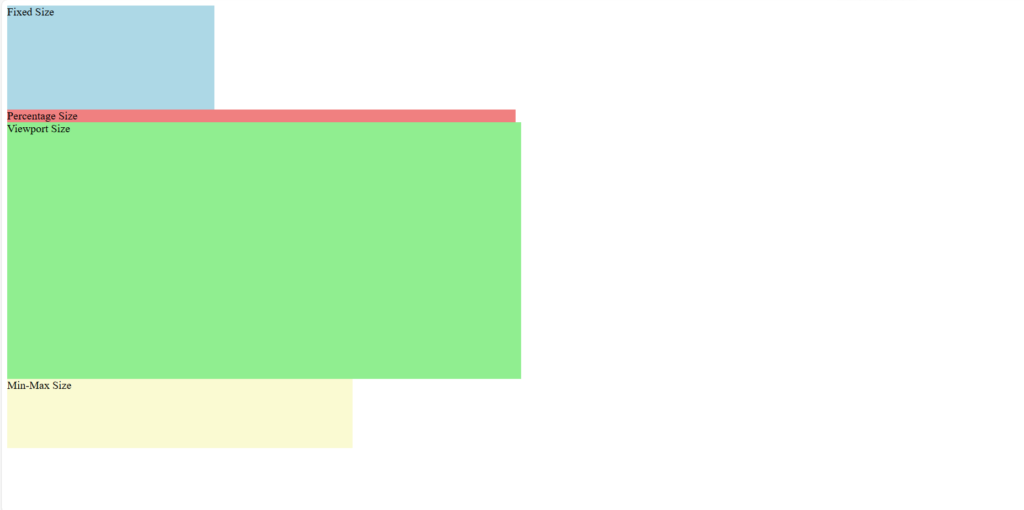
In this instance:
- The height and width of the. fixed-size elements are fixed in pixels.
- The height and width of the. percentage-size elements are expressed as a percentage of the parent element.
- Viewport units are used by the. viewport-size element.
- There are limits on the min-height, max-height, min-width, and max-width values for the. min-max-size element.
Web page responsiveness and layout can be more efficiently controlled by knowing how to apply the height and width parameters.







